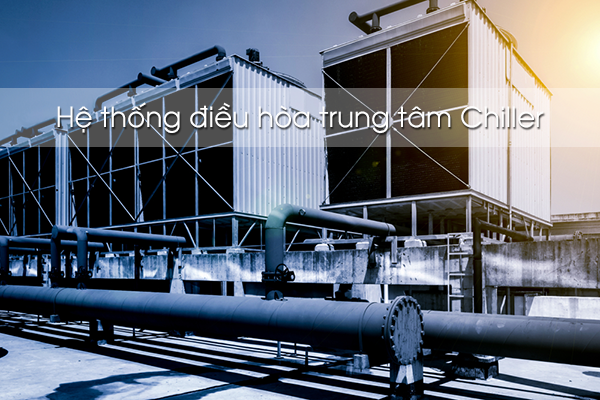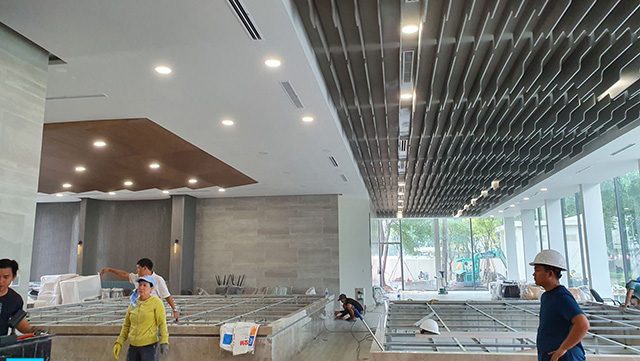Talking about air conditioners must be no stranger to the majority of consumers. However, talking about central air conditioning Chiller, it is still a vague concept that not everyone understands. If you are also having trouble installing a central chiller air conditioning system, please refer to the details below the content of the company P69 !
What is a central chiller air conditioning system?
Chiller central air conditioning system is a cluster of machinery lines that work in combination to create a cold source to be able to cool objects, food, equipment, machinery, etc. The water is cooled through the evaporator. steam normally enters 12°C and exits 7°C. Chiller central air conditioning system is often used for high-rise buildings or commercial centers.

Working principle of central air conditioning system Chiller
The water is transported and recirculated in the pipeline through the chiller cooled down to 7°C. Then flows through the heat exchangers FCU/AHU. The cold water is heat exchanged with the circulating air in the room and causes the room temperature to drop.
At the same time, the temperature inside the chiller system increases to 12°C due to the heat exchange process. Next, the water will be circulated back to the chiller and cooled down to 7°C again. The process is continuously repeated.
Structure of central air conditioning system Chiller
The structure of the system consists of 5 main parts:
- Water chiller center cluster.
- Chilled water piping system and chilled water pump.
- Load system for direct use: AHU, FCU, PAU, PHE, etc.
- Indirectly used load system: Valve system, air duct, air outlet, expansion tank, etc.
- Pumping system – circulating water through Cooling Tower (if any) for water cooling chiller system.
Advantages of central air conditioning system Chiller
- Large operating capacity from 5 to 1000 tons.
- The pipe system is compact, easy to install in locations in the building without taking up much space.
- Stable operation system, high durability can be used for a long time.
- Using chilled water, so you don’t have to worry about refrigerant leakage.
- Easily adjust the operating capacity, humidity for the rooms to help save power consumption, save monthly costs for investors.
- The system is suitable for installation for many large projects.
- The variety in operating capacity as well as types of machines, cooling systems, heat exchangers, etc.
How many types of chiller central air conditioners are there?
There are 2 types of central chiller air conditioners:
1. Central air conditioning system Chiller cooling wind
This system includes central air conditioning, cold air distribution channels, condenser cooling device, etc., which operate according to the mechanism of air cooling and condenser cooling by wind. Accordingly, the central air conditioner produces cold wind and delivers it to the conditioned spaces through the air ducts.
Here, the cold wind acts as a heat exchanger, carrying out the process of receiving heat from the environment in the room, reducing/increasing the temperature and humidity in the room. After completing the process, cold wind is recirculated to the central air conditioner through another wind channel.
2. Water cooling chiller central air conditioning system
This system includes central air conditioning, heat exchangers, condenser cooling equipment, water pump, … operating by the mechanism of water cooling and condenser cooling by wind. Accordingly, cold water produced at central air conditioners is supplied to heat exchangers located in spaces that need air conditioning.
Here, water acts as a heat exchanger, performing the process of receiving heat from the environment in the room, reducing/increasing the temperature and humidity in the room. After completing this process, the water is recirculated to the central air conditioner and continues a new cycle. This water-cooled chiller central air conditioning system is suitable for the air conditioning requirements for different spaces, with different temperature and humidity regimes. Does not require high installation space. The distance between the false ceiling and the bottom is about 100-200 mm.
Instructions for installing central air conditioner chiller properly
In essence when designing or installing chiller central air conditioning systems for buildings or apartments. People often use the air conditioning system in combination with the indoor unit hidden in the ceiling. It is both aesthetically pleasing and safe. The cold air used for cooling will be blown through the air outlet to cool the entire house. . The following are the steps to install a chiller central air conditioning system for your reference.

1. Installation of copper pipes for central air conditioning chiller
Copper pipes need to be selected in accordance with the requirements and standards of the equipment to be installed. Must be insulated both way and return separately need to be wrapped with moisture-insulating nylon. Between the main pipe and the branch pipe is welded together by Refnet joint device to avoid oxidizing the weld.
2. Install the drain pipe
Once the copper pipe installation has been completed, the next step is to install the drain pipe. This pipe needs to use PVC pipe suitable for machine size. The minimum slope is 1/100 and must be adequately insulated. This exhaust pipe will drain centrally along the cold engineering shafts and must have a top vent.
3. Installation of outdoor unit, central chiller (air conditioner) unit
- The indoor unit will be fixed by the machine support nut. The underside of the indoor unit and the underside of the false ceiling must be 10mm apart. The indoor unit should be horizontal for easier condensate drainage.
- The outdoor unit needs to be placed on the concrete pedestal with the specified distance.
4. Electrical system installation and test run
The power source used to operate the air conditioner must be connected to the building’s general electrical system. Each outdoor unit area should install an electrical panel for easy repair and maintenance later. The electrical panel must be made of mild steel rolled plate at least 1mm thick. Install firmly and take care not to expose electricity.
After completing the above steps, we proceed to test run to check. Power on the central controller and set the address for each controller.
Features of central air conditioning system
– Central air conditioner can be placed on the roof or basement technical room. Heat exchangers are located in air-conditioned rooms. The distribution of cold water distribution for the heat exchangers is carried in the technical box and on the false ceiling. Therefore, the installation of the system does not affect the architectural structure of the building.
– The cold supply is through the duct system and the mouth blows from the ceiling to the areas of the air-conditioned room. Therefore, the arrangement of blowers to ensure uniform diffusion of cold air in the room is completely possible.
– For the central system, the replenishment of fresh air is very simple through the duct system fitted with AHU air mixing devices that supply fresh air and mix with the return air of each FCU, AHU .
Due to the water cooling system, the air conditioner runs stably and is less affected by the outside temperature.
– Maximum power saving by low power consumption factor and good system capacity adjustment. During operation, the air conditioner will automatically adjust the compressor capacity to ensure minimum power costs during system operation. This will greatly reduce operating costs for the entire system.
– Durability and long service life over 15 years
– Wide capacity range, can choose the type of machine with the capacity suitable for all kinds of design projects and invest in expanding the system easily.
Contact us today for a free consultation and answer at:
Contact information P69 – M&E Contractor
Address: No. 6/165C Xuan Thuy, Cau Giay District, Hanoi
Website: https://p69.com.vn/
Hotline: 02422121212 – 0965937799
Email: kd@cokhip69.com.vn
Facebook: https://www.facebook.com/p69nhathaucodien
LinkedIn: https://www.linkedin.com/in/congtyp69/
Youtube : https://www.youtube.com/channel/UCOUwCnE5iGj8iqe_ZIUM7oA

